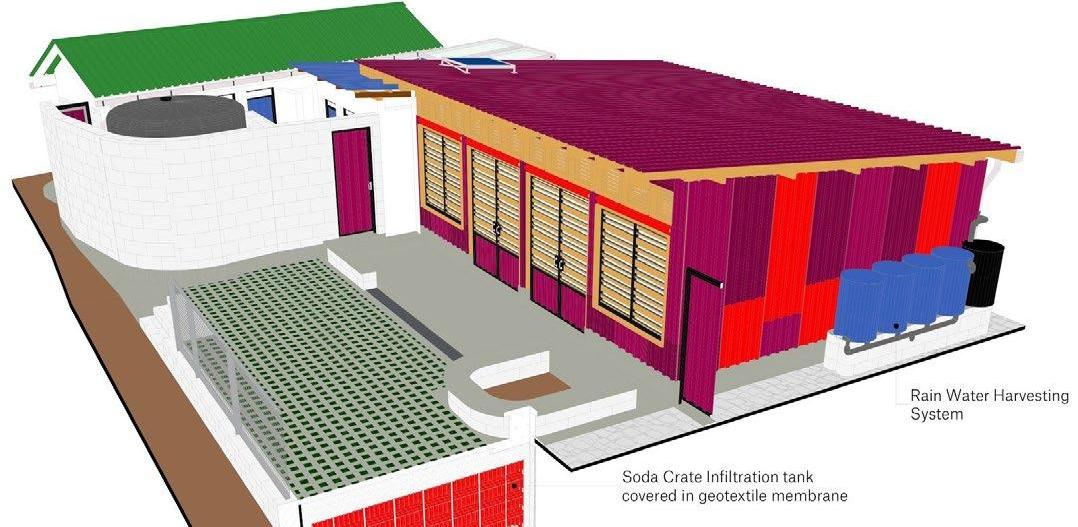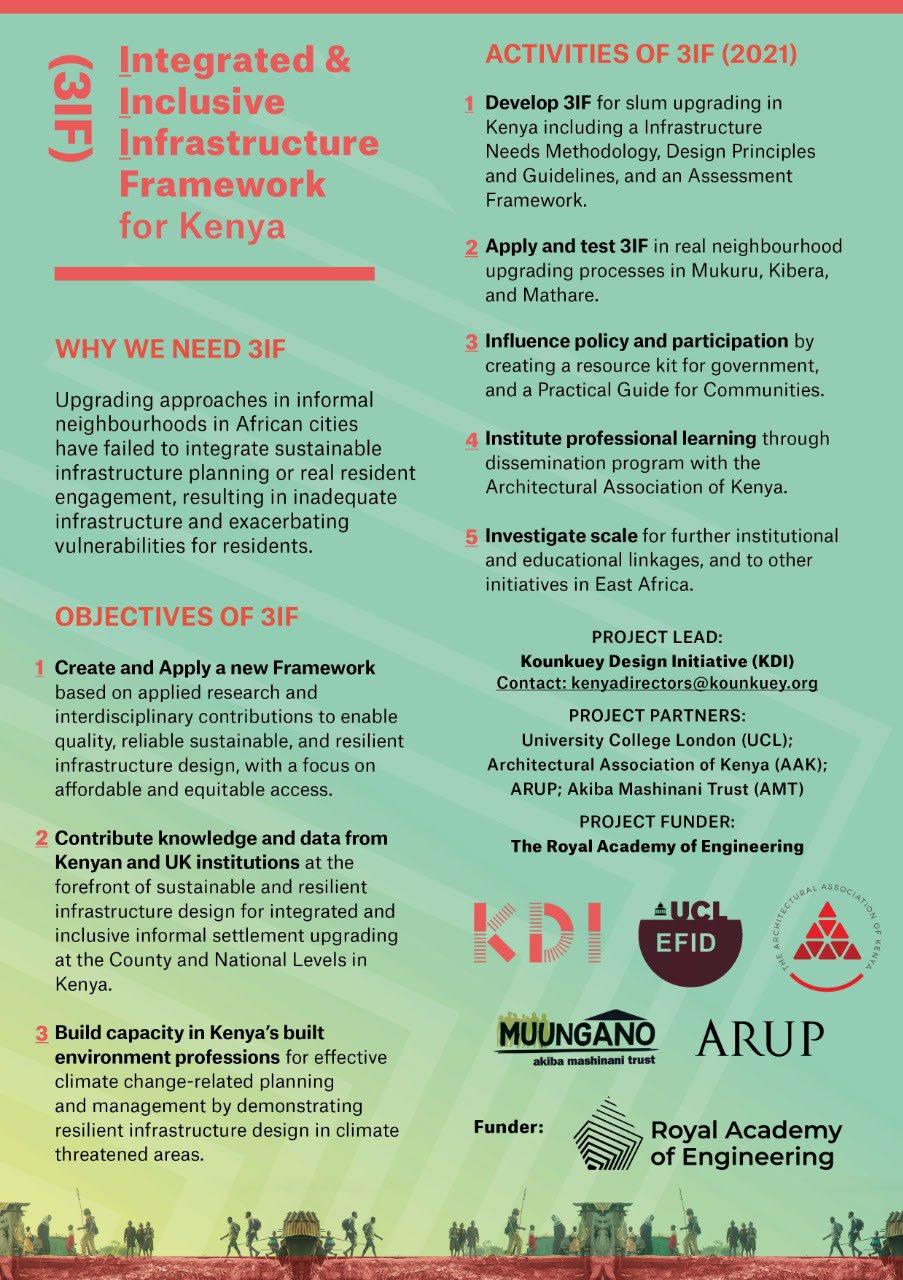
8 minute read
Building Resilience Within Low Income Urban Neighbourhoods by Kounkuey Design Initiative (KDI
Introduction
The most effective means of achieving resilience of a people is to adopt a community-based approach in policy making, planning and implementation of climate change adaptation measures.
Advertisement
African cities are now faced with increased vulnerability to climate change due to scarce resources and limited capacities to adapt to the effects of climate change as pointed out by Siri Eriksen et. al. The urban poor of SubSaharan Africa experience a heightened vulnerability to climate extremes owing to the fact that they live and work in hazardous environments that have poor infrastructure; in addition to inadequate governance structures. (WIREs Clim Change 2014. doi: 10.1002/ wcc.287)
This article seeks to highlight the importance of building resilience through changing the way built environments are planned and constructed to reduce vulnerabilities within low-income neighbourhoods. Based on Kounkuey Design Intiative’s (KDI) decade-long experience working in Kibera, it demonstrates how grassroot level approaches to decision making, context-appropriate innovation, green infrastructure design solutions, and co-development of adaptation measures to climate change with local communities can help residents of low income neighbourhoods build their resilience. KDI has demonstrated that in order to enable these communities to be better prepared to respond, survive and recover from adversities of climate change, an approach that seizes the local knowledge and the assets existing among the people ought to be embraced by practitioners in the built environment, non-profit organisations, the government and civil societies.
Flooding in Kibera, Nairobi
The informal settlements in Nairobi city, like other major growing cities, exhibit a pattern of forming along roads and riverines where flooding is extreme among other adversities such as limited access to potable water, sanitation and electricity. Kibera is an informal settlement and a home to about 250,000-350,000 residents.
The settlement follows the banks of Ngong river, other minor rivers and tributaries lacing through the settlement and culminating in the Nairobi Dam. It continues to grow and densify with the cheapest structures for rent being found along the streambanks where riverine (fluvial) flood risk is highest. Moreover, due to the lack of a waste management system and the poor state of the make-do drainage systems the settlement is also affected by localised (pluvial) flooding. Often, houses get destroyed by being washed away or collapsing.
Impacts of extremities of climate events are more pronounced among the residents of urban informal settlements and are expected to maintain an upward trend with projected increases in rainfall over parts of Eastern Africa. Innovative, sustainable water management is critical to protecting urban ecosystems, developing climate-resilient cities, improving living conditions for the most vulnerable and is key in contributing to sustainable urban development in these densifying neighbourhoods and expanding cities.
BUILDING RESILIENCE WITHIN LOW INCOME URBAN NEIGHBOURHOODS By Kounkuey Design Intiative (KDI)
CASE FOR BUILDING RESILIENCE THROUGH BOTTOM-UP APPROACHES
Policy making and planning in many cases so far has failed to address the needs of the poor, while they are the most vulnerable to climaterelated shocks and stresses. It is essential that we come in to protect the limited physical capital among the low-income populace by improving their climate resilience through the use of appropriate infrastructure and technologies. (Poverty and Climate Change: Reducing the Vulnerability of the Poor through Adaptation, 2003 (Part 2: pages 15-43)
Social networks play a fundamental role for the poor by providing safety nets as an immediate response in times of adversity. Community activism, informal economies and entrepreneurship which exist in poor communities can be strengthened to reduce their vulnerability to climate change. Within the context of poverty, resilience may be understood as the ability of poor individuals and poor communities to recover or ‘bounce-back’ from climatic shocks and stresses. (WIREs Clim Change 2014. doi: 10.1002/wcc.287). In the past, external interventions have often undermined rather than supported the efforts of informal networks.
Participatory design approaches
Over the years, KDI has tested a model that applies inclusion and integrated practices that build on existing local economies and social networks to generate locally-led prosperity. This multidisciplinary approach is a hybrid of solutions incorporating green infrastructure and usercentered design for productive public space.
Construction follows a participatory process through labour selection, skills transfer and understanding functionality of solution with a strong emphasis on gender considerations. This ensures that project realization, completion and sustainability will be attained as the beneficiaries acquire skills during the construction of the project. Further, it enables them to manage and maintain the projects after completion and can take development initiatives on their own to share and scale up the solutions.
Case studies
KDI’s approach to design solutions in informal settlements is informed by the results of the above outlined participatory process. Material choices and construction technology are directed to be ones that the end users are familiar with, if possible, or that can easily be learned about and understood. The building phase of these design solutions involves use of local labour to ensure the skills transfer as well as ensure proper functionality and a sense of project ownership post handover. Ultimately, the aim is to equip the communities with skills and understanding to be able to maintain the co-developed solutions as well as replicate them on their own.
Nature Based Solutions at St. John’s School Kibera
Nature Based Solutions to flooding and waste water management are based on learnings from nature’s abilities to handle these challenges and adapting them into built interventions. They are win-win solutions that involve protecting, restoring and sustainably managing ecosystems to address society’s challenges and promote human well-being.
The project site was a community school in Silanga, Kibera located about 40 metres from the Ngong River. The school has been affected heavily by pluvial floods as well as flooding from surface runoff flowing down towards the river.

KDI sought to build an integrated nature based water management system to address this challenge working with the community to co-design, build, implement and evaluate their suitability to address these challenges in these neighbourhoods.
The integrated system agreed on after a series of community workshops included rainwater harvesting systems, rain gardens, infiltration tanks and filter drains. The capture and detention of storm and rainwater helps to reduce the volume of water flowing into watercourses, and therefore can help to reduce the risk of flooding downstream. Less water flowing over the ground also helps reduce erosion.
Sustainable Urban Drainage Solutions in VUMA
VUMA is a youth group that co-designed and lent its name to the eleventh Kibera Public Space Project located in Makina village, Kibera. Issue 03 | March 2021
Comprising two sanitation buildings and a community hall, the project takes advantage of several social, economic and environmental resilience strategies including community organized labour and renewable energy systems.
However, this article will focus on the Sustainable Urban Drainage Solutions strategies adopted in the project. Sustainable Urban Drainage Solutions are water management strategies aimed at aligning modern drainage systems with natural water processes. Ground conditions in the VUMA project site posed a challenge due to low infiltration rates of the soil in part due to the numerous pit latrines covered after filling up and the scarcity of open spaces due to the high density of buildings. VUMA’s stormwater management strategy focused on reducing surface water runoff from the project site by capturing, enhanced infiltration and storage. The facility has guttered roofs with rainwater downpipe systems draining into a rainwater harvesting system and a rain garden. Rain water from the community hall roof is captured into a system of 200l water tanks to be used by the community. A rain garden and an infiltration tank are installed to improve soil infiltration rates.
The infiltration tank located beneath the community hall plaza is made up of about 560 soda crates wrapped in a geotextile fabric and covered in gravel and a layer of permeable concrete paving. Working in concert, these drainage solutions significantly reduce the amount of surface runoff joining the surface water drainage network in the village from the VUMA site.
The KDI projects have been a success in getting solutions built and operationalized; which is no small feat in informal settlements. However, the impact of these interventions is currently small and a long way from achieving what is required to see actual transformation at a settlement scale. To achieve wider adoption of these solutions, support is needed from built environment professionals combined with more central roles for other stakeholders (local and national governments, CBOs, NGOs and private sector). Stakeholder awareness and understanding of climate change and its risks, as well as a need for environmental design is key to achieving this improvement.
Although policies on addressing climate change in urban planning and design (construction processes) exist, there is a need to raise the importance given to climate change adaptation and to demonstrate how these policies can be translated into practical, effective, community-based adaptation measures. A link needs to be forged between the local experience and needs of communities and the higher level policy makers.
Kounkuey Design Initiative (KDI) Profile
Kounkuey Design Initiative (KDI) is a non-profit design and community development organization. We partner with under-resourced communities to advance equity and activate the unrealized potential in neighbourhoods and cities. We accomplish this mission through advocacy, research, planning and built works.
KDI was founded in 2006 by harvard design students. Keen to use their design skills to alleviate economic, environmental and social challenges, they travelled to Nairobi, home of one of the co-founders, and began codesigning and building their first projecct with residents of Kibera, an informal settlement. The KDI founders believed that their design skills would not be useful unless the local residents were actively guiding them. This led them to develop a model of participatory practice that followed a simple pattern: ask, listen, collaborate and repeat.
KDI has since grown into an interdisciplinary firm with project experience in diverse settings, from urban informal settlements inKenya, to rural farmworker communities in the US, as well as urban and rural settings in Morocco, Mexico, Haiti and Ghana. Today, KDI has offices in Nairobi, Los Angeles, and Stockhom, and employs 41 staff members, which include planners, landscape architects, engineers, designers, researchers, and community organizers.
Our work encompasses 4 distinct but interrelated service areas: Design+Build, Plan+ Program, Research+Test, Advocate+Educate.






